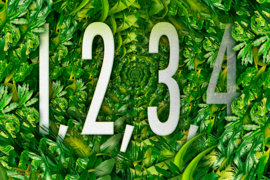Among many of the Tsimane’ people, who live in a remote region of the Bolivian rainforest, numbers do not play an important role in their lives, and people living in this society vary widely in how high they can count.
A new study from MIT and the University of California at Berkeley has found a relationship between the counting ability of Tsimane’ individuals and their success at matching tasks that involve numbers up to about 25. The researchers found that most subjects could accurately perform tasks that require matching numbers of objects, but only up to the highest number that they could count to.
The results suggest that in order to represent an exact quantity larger than four, people may need to have a word for that number, says Edward Gibson, an MIT professor of brain and cognitive sciences.
“This finding provides the clearest evidence to date that number words play a functional role in people’s ability to represent exact quantities larger than four, and supports the broader claim that language can enable new conceptual abilities,” says Gibson, one of the authors of the new study.
Berkeley postdoc Benjamin Pitt is the lead author of the paper, which appears today in Psychological Science. Steven Piantadosi, an assistant professor of psychology at Berkeley, is the senior author of the study.
Words count
The Tsimane’ are a farming and foraging society of about 13,000 people in the Amazonian rainforest. Most Tsimane’ children start going to school around age 5, but education levels and counting ability vary considerably. The Tsimane’ language has words for numbers up to 100, and words for numbers larger than that are borrowed from Spanish.
In a 2014 study, Gibson, Piantadosi, and former MIT graduate student Julian Jara-Ettinger found that Tsimane’ children learn the meanings of number words along the same developmental trajectory as children in industrialized societies. That is, first they understand “one,” then they add “two, “three,” and “four,” in sequence. At that point, however, a dramatic shift in understanding takes place, and children grasp the meanings of not only “five” and “six,” but all of the number words they know.
Children in industrialized societies, which place a much greater emphasis on numbers, begin to learn to count around age 2 and have a sophisticated understanding of numbers and counting by age 4 or 5. However, among the Tsimane’, this trajectory occurs later, beginning around age 5 and ending around age 8.
For the new study, Gibson and his colleagues identified 15 Tsimane’ people who could count to somewhere between six and 20, and 15 who could count to at least 40. This gave them the opportunity to compare individuals with different verbal counting abilities and to test the hypothesis that without number words, people are unable to do exact matching tasks that require them to mentally represent numbers greater than four.
To study this question, the researchers used a task known as “orthogonal matching.” In the simplest matching task, researchers would present a line of objects, such as batteries, and then ask the participants to line up an equivalent number of a different object, such as spools of thread. With orthogonal matching, the objects are presented in a horizontal line but the participants must line up the corresponding number vertically, so they can’t simply match them one-to-one.
The MIT team found that the Tsimane’ people were able to perform this task, but only up to just below the number they can count to. That is, someone who can count to 10 would start making mistakes when asked to match eight or nine objects, while someone who can count to 15 would start making mistakes around 13 or 14.
Number representations
The findings suggest that tasks that require manipulation of numbers can only be done using number words or other explicit systems for representing numbers, Gibson says.
“When we get to larger numbers, even just five and six, we need some way to represent that if you want to represent it exactly,” he says. “It doesn’t have to be words — you could use your fingers or something like that — but you need some kind of independent representation of the numbers.”
In future work, Gibson hopes to further study how children learn number representations, which is easier to do with Tsimane’ participants because they learn numbers at an older age than children in Western societies.
The research was funded by the National Science Foundation and the James S. McDonnell Foundation.










